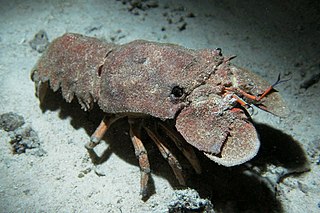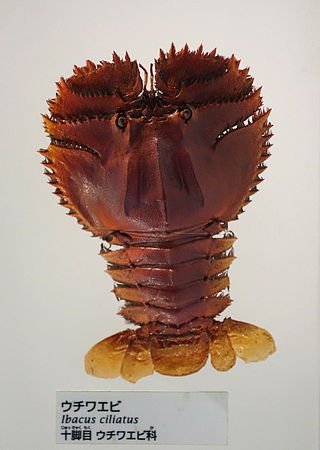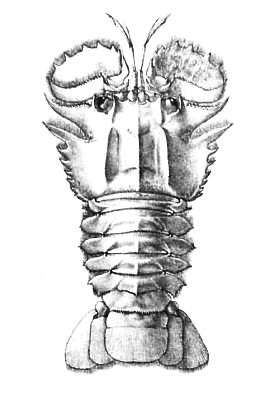
Slipper lobsters are a family (Scyllaridae) of about 90 species of achelate crustaceans, in the Decapoda clade Reptantia, found in all warm oceans and seas. They are not true lobsters, but are more closely related to spiny lobsters and furry lobsters. Slipper lobsters are instantly recognisable by their enlarged antennae, which project forward from the head as wide plates. All the species of slipper lobsters are edible, and some, such as the Moreton Bay bug and the Balmain bug are of commercial importance.

The Cape lobster, Homarinus capensis, is a species of small lobster that lives off the coast of South Africa, from Dassen Island to Haga Haga. Only a few dozen specimens are known, mostly regurgitated by reef-dwelling fish. It lives in rocky reefs, and is thought to lay large eggs that have a short larval phase, or that hatch directly as a juvenile. The species grows to a total length of 10 cm (3.9 in), and resembles a small European or American lobster; it was previously included in the same genus, Homarus, although it is not very closely related to those species, and is now considered to form a separate, monotypic genus – Homarinus. Its closest relatives are the genera Thymops and Thymopides.

Ibacus peronii, the Balmain bug or butterfly fan lobster, is a species of slipper lobster. It lives in shallow waters around Australia and is the subject of small-scale fishery. It is a flattened, reddish brown animal, up to 23 cm (9 in) long and 14 cm (6 in) wide, with flattened antennae and no claws.
Metanephrops boschmai, known as the Bight lobster, Bight scampi or Boschma's scampi, is a species of lobster endemic to Western Australia.

Acanthacaris is a genus of deep-water lobsters. It contains two species, A. caeca and A. tenuimana, and is the only genus in the subfamily Neophoberinae.
Justitia mauritiana is a species of spiny lobster, sometimes called the gibbon furrow lobster. It lives in the western Indian Ocean around the Mascarene Islands, and also around the Hawaiian Islands. Larvae supposed to belong to this species have been reported around the Philippines, the Gilbert Islands and Tahiti. It grows to a total body length of 16 centimetres (6.3 in), and this small size, together with its scarcity and the difficulties of fishing for lobsters on rocky substrates, means that the species is not commercially exploited. J. mauritiana is also treated as a subspecies of Justitia longimanus.

Scyllarides latus, the Mediterranean slipper lobster, is a species of slipper lobster found in the Mediterranean Sea and in the eastern Atlantic Ocean. It is edible and highly regarded as food, but is now rare over much of its range due to overfishing. Adults may grow to 1 foot (30 cm) long, are camouflaged, and have no claws. They are nocturnal, emerging from caves and other shelters during the night to feed on molluscs. As well as being eaten by humans, S. latus is also preyed upon by a variety of bony fish. Its closest relative is S. herklotsii, which occurs off the Atlantic coast of West Africa; other species of Scyllarides occur in the western Atlantic Ocean and the Indo-Pacific. The larvae and young animals are largely unknown.

Scyllarides is a genus of slipper lobsters.

Parribacus japonicus, the Japanese mitten lobster, is a species of slipper lobster. Though the common name for this lobster is the Japanese mitten lobster, it is locally called zōri-ebi (ゾウリエビ) – zōri denoting the Japanese sandal it resembles, and ebi meaning shrimp or lobster.
Eunephrops manningi, the banded lobster, is a species of lobster found in the West Indies. It was named in 1974 by carcinologist Lipke Holthuis after his friend and fellow carcinologist Raymond B. Manning.

Arctides is a genus of slipper lobsters, containing three species. The largest of these, A. antipodarum, has a carapace up to 100 millimetres (3.9 in) long, and is found off south-eastern Australia and parts of New Zealand. The other two species are smaller, at up to 70 millimetres (2.8 in) carapace length; A. guineensis is found in an area similar to the Bermuda Triangle; A. regalis is widely distributed in the Indo-Pacific, from the Mascarene Islands to Hawaii and Easter Island.

Scyllarides aequinoctialis is a species of slipper lobster that lives in the western Atlantic Ocean from South Carolina to São Paulo State, Brazil, including the Gulf of Mexico, Caribbean Sea, and Bermuda. Its common name is Spanish slipper lobster. It grows up to 30 centimetres (12 in) long, with a carapace 12 cm (4.7 in) long. S. aequinoctialis is the type species of the genus Scyllarides and the first species of slipper lobster to be described from the Western Atlantic.

Panulirus homarus is a species of spiny lobster that lives along the coasts of the Indian and Pacific Oceans. It lives in shallow water, and feeds on the brown mussel Perna perna. It typically grows to a length of 20–25 cm (7.9–9.8 in). Alongside the dark green nominate subspecies, two red subspecies are recognised, one around the Arabian Peninsula, and one around southern Africa. It is the subject of small-scale fishery.
Scyllarus pygmaeus is a species of slipper lobster that lives in shallow water in the Mediterranean Sea and eastern Atlantic Ocean. It grows to a length of 55 mm (2.2 in), which is too small for it to be fished for food. The juvenile form was first described in 1885, with the description of the adult following in 1888 as a result of the Challenger expedition.
Galearctus avulsus is a species of slipper lobster that lives around New Caledonia. It was described in 2011, having previously been included in Galearctus kitanovirosus. It differs from the other species of the genus Galearctus most noticeably in the shape of a groove on the sternum.

Neoglyphea inopinata is a species of glypheoid lobster, a group thought long extinct before Neoglyphea was discovered. It is a lobster-like animal, up to around 15 centimetres (5.9 in) in length, although without claws. It is only known from 17 specimens, caught at two sites – one at the entrance to Manila Bay in the Philippines, and one in the Timor Sea, north of Australia. Due to the small number of specimens available, little is known about the species, but it appears to live up to five years, with a short larval phase. A second species, previously included in Neoglyphea, is now placed in a separate genus, Laurentaeglyphea.
Nephropides caribaeus is a species of lobster, the only species in the genus Nephropides. It is found in western parts of the Caribbean Sea, from Belize to Colombia. It grows to a total length of around 170 mm (6.7 in), and is covered in conspicuous tubercles.

Geryon trispinosus is a species of crab that lives in deep water in the north-eastern Atlantic Ocean.

Ibacus ciliatus is a species of slipper lobster from the north-west Pacific Ocean.

Ibacus alticrenatus is a species of slipper lobster that lives in the waters of Australia and New Zealand.












